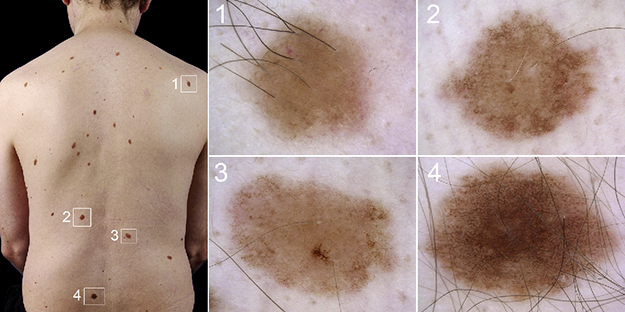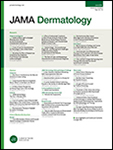 An article in which the University of Arizona Division of Dermatology’s Clara Curiel-Lewandrowski, MD, was co-author was picked up by JAMA Dermatology for publication on Oct. 10.
An article in which the University of Arizona Division of Dermatology’s Clara Curiel-Lewandrowski, MD, was co-author was picked up by JAMA Dermatology for publication on Oct. 10.
Primary author on the article, “Risk of Subsequent Cutaneous Melanoma in Moderately Dysplastic Nevi Excisionally Biopsied but with Positive Histologic Margins,” was Caroline Kim, MD, of Harvard Medical School and Beth Israel Deaconess Medical Center in Boston.
Clinical image (right) of a patient with dysplastic nevus syndrome. Dermatoscopically (1–4), it can be seen that some of the large dysplastic nevi, or atypical moles, are congenital nevi by the presence of terminal hairs. (Credit: Dermatologic Clinics)
The article was co-authored by 20 members of the Pigmented Lesion Subcommittee, Melanoma Prevention Working Group (MPWG). The MPWG is a national multidisciplinary and multi-institutional organization affiliated with the U.S. Cooperative Oncology Groups and the National Cancer Institute to specifically address gaps in the field of cutaneous melanoma and pigmented lesions.  Dr. Curiel-Lewandrowski was one of the founding members leading to the establishment of this organization in 2002.
Dr. Curiel-Lewandrowski was one of the founding members leading to the establishment of this organization in 2002.
She also is a professor of medicine; a physician-scientist with the UA Skin Cancer Institute and UA Cancer Center; and director of the Cutaneous Oncology Program and Pigmented Lesion Clinic at Banner – University Medical Center Tucson and South.
She recently was recognized by the Arizona Bioindustry Association as the 2018 Arizona Bioscience Researcher of the Year.
 The central question of the article is can moderately dysplastic nevi (DN)—or atypical moles—that have been excisionally biopsied with no residual clinical pigmentation but with positive histologic margins be closely observed instead of reexcised?
The central question of the article is can moderately dysplastic nevi (DN)—or atypical moles—that have been excisionally biopsied with no residual clinical pigmentation but with positive histologic margins be closely observed instead of reexcised?
The authors in this multicenter cohort study of 467 moderately DNs found no cases of cutaneous melanoma at the biopsy site after a mean follow-up time of nearly seven years, but patients with 2 or more biopsied moles had an increased risk of developing a subsequent cutaneous melanoma at a separate site.
They determined that screening for subsequent cutaneous melanoma at separate sites seems warranted for individuals with multiple histologic dysplastic nevi. This article has the potential to significantly impact the everyday care of thousands of DN patients with frequently biopsied pigmented lesions…
EXTRA INFO: Melanoma Walk 2018
The UA Skin Cancer Institute at the UA Cancer Center will present the ninth annual Melanoma Walk on Saturday, Nov. 3, on the UA Mall, 1209 E. University Blvd. Activities begin at 3:30 p.m. and the walk starts at 5 p.m.
The walk is family- and pet-friendly and includes prizes and giveaways, music, food, a silent auction and activities for kids. Registered participants receive a “goody bag” and food. Before the walk—2:30-4:30 p.m.—free skin care screenings and spot checks are available to all. First come, first served. Visitors need not be registered for the event to receive free screenings.
Proceeds from the walk directly support melanoma research, community outreach, education and patient care in Arizona. The UA Skin Cancer Institute’s goal is to raise $75,000 to help fight melanoma.

